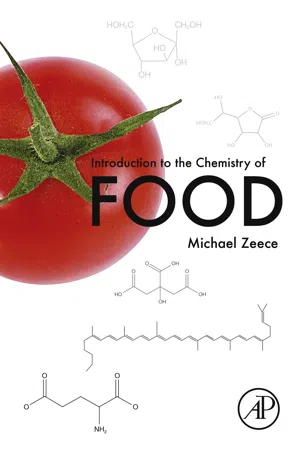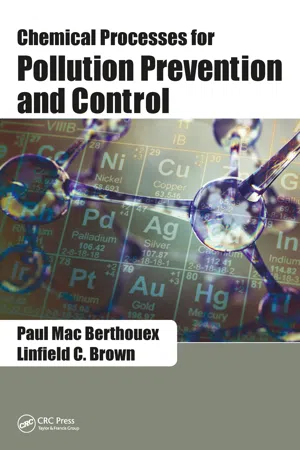Chemistry
pH and pOH
pH and pOH are measures of the acidity and basicity of a solution, respectively. pH is the negative logarithm of the hydrogen ion concentration, while pOH is the negative logarithm of the hydroxide ion concentration. Both pH and pOH are used to quantify the strength of acids and bases in a solution, with lower values indicating higher acidity or basicity.
Written by Perlego with AI-assistance
Related key terms
10 Key excerpts on "pH and pOH"
- eBook - ePub
- Patrick E. McMahon, Rosemary McMahon, Bohdan Khomtchouk(Authors)
- 2019(Publication Date)
- CRC Press(Publisher)
Chapter 23 ). Interconversion of pH and pOH is accomplished with the use of the following equations:Most of the possible reactions of acids or bases with water can be organized into four categories to aid in selection of the correct solution techniques.p H= −l og[1 0H +(]a q)p O H= −l og[ O1 0H −(] [a q)H +(] =a q)a n t i l o g( −p H) = 10[ O−p HH −(] =a q)a n t i l o g( −p O H) = 10−p O Hp H+p O H=1 4Category (1): Strong acids in water. All strong acids can be considered nearly 100% dissociated in water due to the large values of the equilibrium constant. In these cases, the concentration of H+(aq) is determined by solving the simple solution stoichiometry of the reaction; for a monoprotic acid, [H+(aq) ] in a solution of the acid is approximately equal to the initial concentration of the strong acid.Category (2): Strong hydroxide bases in water. The concentration of OH− (aq) is determined by simple solution stoichiometry based on the number of hydroxide ions in the formula of the base. Although not common for topics in this chapter, strong non-hydroxide bases are analyzed though a stoichiometric reaction with water as the acid.Category (3): Weak acids in water. The concentration of H+(aq) is determined by solving the acid dissociation equilibrium from a given value for Ka . An alternative problem is the calculation of the value of Ka from a given value for pH or pOH.Category (4): Weak bases in water. The concentration of OH− (aq) is determined by solving the equilibrium reaction of the weak base with water as the acid, given the value for Kb . An alternative problem is the calculation of the value of Kb from a given value for pH or pOH.Example: Calculate the pH and pOH of a 2.5 M solution of HCl (strong acid).The reaction of a strong acid in water is an example of category (1). [H+(aq) ] is determined by solving the simple stoichiometry that assumes that HCl is ≅ 100% ionized. Complete reaction of the limiting reagent (water is in excess) means that [H+(aq) ] ≅ [H—Acid]initial . Use any necessary techniques described in Chapter 8 . The first requirement is to write the correct balanced equation (Chapter 9 - eBook - ePub
Environmental Process Analysis
Principles and Modeling
- Henry V. Mott(Author)
- 2013(Publication Date)
- Wiley(Publisher)
eq ).Given the electrochemical nature of the measurement technique, the measured abundance is in fact the chemical activity of the protons in the solution. We have encountered this chemical activity term earlier and determined that detailed consideration must wait until chapter 10 of this text when we are more fully armed with understandings allowing us to fully appreciate its significance. Thus, for now we will revert to the more familiar definition that pH = −log10 [H+ ] (and the reverse that [H+ ] = 10–pH ), leaving examination and application of the true definition that pH = −log10 {H+ } (−log10 of the molar activity of hydrogen ions) until we embrace the advanced topics of Chapter 10.We could delve into the specific electrochemistry of the pH meter, developing full understandings regarding the bases of the measurement process, but will not. These understandings are published in numerous sources. Although vital to the overall understanding of and refinement of methods for the measurement of pH, assimilating these understandings is beyond the scope of this textbook.Let us examine the hydrogen ion (or proton) in light of the discussion of Chapter 2 relative to the attraction of water to ions in aqueous solution. Once its electron is donated from the hydrogen atom, what remains is the proton situated in the nucleus of the ion with a residual unit positive charge. Then, in aqueous solution, water molecules arrange themselves via short-range bonds between the partial negative of the oxygen and the positive charge of the proton. The first four water molecules tend to orient themselves in a tetrahedral structure. The bonds between the coordinating water molecules and the proton are quite strong. We will leave the computation of the bond energy to the physical chemists. Given that these first four water molecules in no way satisfy the positive charge, additional water molecules are free to orient with the resultant proton–water structure, forming another layer, still strongly bonded to the positive charge, but certainly less so than the inner four. Additional layers of water, each with successively weaker bonds, are added to the overall positively charged ionic structure. In discussions of the relation between the ionic content of water and the activity coefficient (relating molar activity to molar concentration), Dean (1992) lists the ion size parameter (the hydrated radius) of the hydrogen ion as nine angstroms (Å). We can then envision (this works best if we close our eyes and imagine that we can see both the proton and the water molecules) a layered sphere, each layer being a spherical shell, of ordered water molecules surrounding the proton. Within each shell the oxygen atom of each water molecule would tend to be oriented toward the center relative to the hydrogen atoms. Figure 6.1 is a two-dimensional, quite simplistic representation of the general configuration. Given that the water molecules, as a consequence of their innate energy manifest as translational, rotational, and vibrational motion are always on the move, the structure would be dynamic with continual exchange of water molecules. Further, rather than orient in “layers” the water molecules might tend to orient in a much less ordered manner. Regardless of the details, we leave Figure 6.1 - eBook - ePub
- Jeffrey Gaffney, Nancy Marley(Authors)
- 2017(Publication Date)
- Elsevier(Publisher)
+ ]. Although theoretically the pH scale is open-ended, most pH values fall in the range from 0 to 14.Table 5.3 Molar Hydronium and Hydroxide Ion Concentrations for pH Values From 0 to 14pH [H+ ] [OH− ] 0 1.0 0.00000000000001 1 0.1 0.0000000000001 2 0.01 0.000000000001 3 0.001 0.00000000001 4 0.0001 0.0000000001 5 0.00001 0.000000001 6 0.000001 0.00000001 7 0.0000001 0.0000001 8 0.00000001 0.000001 9 0.000000001 0.00001 10 0.0000000001 0.0001 11 0.00000000001 0.001 12 0.000000000001 0.01 13 0.0000000000001 0.1 14 0.00000000000001 1.0 The pH of pure water at 25°C can be calculated from the concentration of [H3 O+ ] in pure water, which is equal to 1.0 × 10− 7 M.pH = − log1 ×= −10− 7log 1.0 + log= −10− 70 += 7.00− 7Acidic solutions will have a higher [H3 O+ ] than pure water (values > 1 × 10− 7 ). So, the pH values of acidic solutions will be less than 7.0. Since basic solutions will have a lower concentration of [H3 O+ ] than pure water (values < 1 × 10− 7 ), the pH values of basic solutions will be greater than 7.0. The lower the pH value, the higher the hydronium ion concentration and the stronger the acid solution. Similarly, the higher the pH value, the lower the hydronium ion concentration and the stronger the basic solution (Fig. 5.6 ).Fig. 5.6 - eBook - ePub
Rapid Review of Chemistry for the Life Sciences and Engineering
With Select Applications
- Armen S. Casparian, Gergely Sirokman, Ann Omollo(Authors)
- 2021(Publication Date)
- CRC Press(Publisher)
−14 .The pOH may be analogously computed for basic solutions:In addition, sincepOH = − log(3.3)[OH −]it is always possible to find pOH from pH, or vice versa.pH + pOH = 14.0(3.4)For the more commonly used pH, the acid range of solutions is 0–7, while the basic or alkaline range is 7–14. A pH of 7.0 represents a neutral solution such as distilled water in which the hydrogen ion concentration and the hydroxide ion concentration are both equal to 1.0 × 10−7 M. The pH values of common substances are shown in Figure 3.1 .Properties of acids include the following:FIGURE 3.1 The pH of some common substances.- They taste sour.
- They neutralize bases to produce water and a salt.
- They react with many metals to yield H2 gas.
- They are strong dehydrating agents.
- They taste bitter.
- They feel slippery.
- They react with fats and oil.
- They neutralize acids to produce water and a salt.
3.3 Calculations for Strong Acids and Bases
Examples 3.1 –3.8 represent routinely encountered problems and calculations for strong acids and bases. In general, 1 mole of acid (H+ ion) neutralizes 1 mole of base (OH- ion) to produce 1 mole of water (H2 O).Example 3.1: (A & B) Understanding Molarity of a Strong Acid An aqueous solution of hydrochloric acid is 0.034 M. Find:- [H+ ]
- [Cl− ]
SolutionSince HCl is a strong acid, it dissociates and ionizes completely (i.e., 100%) into its component ions. Thus,- [H+ ] = 0.034 M
- [Cl− ] = 0.034 MIt is safe to assume that [HCl] in terms of molecules is 0.
Example 3.2: (A & B) Molarity and pH Calculations of a Strong AcidFor a 0.035 M HNO3 solution, find:- [H+ ]
- pH
Solution- HNO3 is a strong acid. Thus, a 0.035 M solution of HNO3 yields 0.035 M H+ ions (and 0.035 M NO3 − ions), since there is a complete dissociation and ionization.
- So, [H+
- eBook - ePub
- Michael Zeece(Author)
- 2020(Publication Date)
- Academic Press(Publisher)
Writing numbers this way is tedious and leads to mistakes (e.g., adding or leaving out a zero) that are avoided by using exponential (scientific) notation as shown below. 0.000000 1 M H 3 O + = 1.0 × 10 − 7 M H 3 O + pH and measuring acidity pH is the term used to express the measurement of hydronium ion concentration in solution. The chemical definition of pH is given as “the negative log of the hydronium concentration” and corresponds to the following equation. pH = − Log [ H 3 O + ] This equation of acidity is very useful and often employed to find the pH of materials (in solution) including water, soil, and food. The hydronium ion concentration of pure water at 25 °C is 1.0 × 10 − 7 M. Using the equation for pH, the value for water under these conditions is 7. pH = − Log [ 1.0 × 1 0 − 7 M ] pH = − (− 7) pH = 7 This equation can be used to find the pH of soda pop and egg white, as shown below. Soda pop contains phosphoric acid and is an acidic food. The hydronium ion concentration of a typical pop is 1.0 × 10 − 4 M, therefore its pH is: pH = − Log (1.0 × 1 0 − 4 M) pH = − (− 4) pH = 4 Egg white, in contrast to soda pop, represents one of the few alkaline foods. This means it contains a enough base to raise its pH above 7. The hydronium ion concentration of egg white is 1.0 × 10 − 8 M. Therefore, its pH is: pH = − Log (1.0 × 1 0 − 8 M) pH = − (− 8) pH = 8 The pH scale ranges from 1 to 14, with pH 1 being very acidic and pH 14 being strongly basic (alkaline). One of the only places to find a substance with a pH of 1 is inside the stomach. Its digestive fluid contains HCl and the pepsin enzyme essential to digestion. The highly acidic environment denatures proteins and makes their breakdown by pepsin more effective - eBook - ePub
Chemistry
Concepts and Problems, A Self-Teaching Guide
- Richard Post, Chad Snyder, Clifford C. Houk(Authors)
- 2020(Publication Date)
- Jossey-Bass(Publisher)
The pH, sometimes called the “hydrogen ion exponent,” is defined mathematically as the negative logarithm to the base 10 of the hydrogen ion concentration. For the following H + ion concentrations, compare the power of 10 exponent with the corresponding value of pH. Answer: 6 If the hydrogen ion concentration is 1 × 10 –(exponent), then the pH is equal to the exponent. Or, expressed another way: If a solution has a pH of 3, what is the hydrogen ion concentration? _____ Answer: [H + ] = 1 × 10 −3 M What is the pH of pure neutral water? __________ Answer: A solution is acidic if [H + ] is greater than 1 × 10 −7 M. A solution is alkaline if [H + ] is less than 1 × 10 −7 M. Is a solution with a pH of 6 acidic or alkaline? __________ Answer: acidic (The [H + ] = 1 × 10 −6, which is greater than 1 × 10 −7.) To determine the pH of a solution if the [H + ] is something other than 1 × 10 –(exponent) requires use of common logarithms (log to the base 10). Some instructors may arrange problems so that all [H + ] will be 1 × 10 –(exponent) to simplify calculations. More often than not, [H + ] is something other than 1 × 10 –(exponent). We have chosen such examples and included a log table for your use in the Appendix. You may also use your scientific calculator or the handy calculators available on the Internet by way of a web browser and search engines. In this book, the answers to problems involving logarithms will assume you understand and know how to use logarithms. To determine the pH of a hydrogen ion concentration of n × 10 –(exponent), where n is a number other than 1, we must determine the logarithm of the number n. Determine the pH of a solution if [H + ] = 3 × 10 −5 (to the nearest hundredth) - Paul Mac Berthouex, Linfield C. Brown(Authors)
- 2017(Publication Date)
- CRC Press(Publisher)
− ], and vice versa. For example,[H+ ] = 10−2 and [OH− ] = 10−12[H+ ] = 10−3 and [OH− ] = 10−11[H+ ] = 10−9 and [OH− ] = 10−5where [H+ ] = hydrogen ion concentration (mol/L)[OH− ] = hydroxyl ion concentration (mol/L)KWis temperature dependent, as shown in Table 7.1 .TABLE 7.1The Ionization of Water (KW) Is a Function of Temperature7.4 pH
pH is a fundamental characteristic of chemical solutions. It determines the extent of ionization of soluble compounds and the formation of solids by ions that tend to precipitate. Low pH indicates acidic conditions.The definition of pH ispH = −log10 [H+ ]This convenient “p” notation saves us having to write the concentrations as exponentials. The “p” comes from “potential,” and the formula −log10 [X ] is used in other cases where logarithmic values are easier to understand.Taking negative logarithms of the equilibrium expression for water,
The pH scale for aqueous solutions runs from 0 to 14. A change of one pH unit represents a 10-fold change in [H+].KW= [H+ ][OH− ] = 10−14gives −log10KW= −log10 [H+ ]−log10 [OH− ] = 14and pKW= pH + pOH = 14At pH = 2 [H+] = 10−2 and [OH− ] = 10−12pH = 3 [H+ ] = 10−3 and [OH− ] = 10−11pH = 9 [H+ ] = 10−9 and [OH− ] = 10−5Table 7.2 shows howKWand the neutral pH depend on temperature. Even though the pH of pure water changes with temperature, it is still neutral. In pure water, there will always be the same number of hydrogen ions and hydroxide ions. That means that the pure water remains neutral even if its pH changes.We are strongly conditioned to the idea of 7 being the pH of pure water, and anything else feels strange. Remember that if the value ofKW- eBook - ePub
Soil Science
Methods & Applications
- David L. Rowell(Author)
- 2014(Publication Date)
- Routledge(Publisher)
Section 8.1 explains the terms involved. It should be noted that when applied to soils, ‘neutral’ is given a slightly different meaning, being a range from about pH 6.5 to 7.Soil acidity involves more than just the pH of the soil solution. This is still the main principle and the measurement of soil pH (Section 8.1 ) is normally made in a suspension of soil in water such that the value obtained is primarily related to the solution pH. However, hydrogen ions are also present on cation exchange sites and have an effect on the measurement. Also as soils become more acidic (pH 7 → 3), there are associated changes in the following properties:• The amounts of exchangeable Ca2+ and Mg2+ decrease. These together with exchangeable K+ , Na2+ and are known as the basic cations: their total amount is often expressed as a percentage of the CEC which is termed the percentage base saturation (Section 8.2 ).• The amount of exchangeable Al3+ increases and is often expressed as the percentage aluminium saturation of the ECEC (Section 8.2 ).• The negative charge on humus decreases and the positive charge on sesquioxides increases (Sections 7.1 and 7.5 ).• The availability of plant nutrients is changed. For example, phosphate solubility is reduced (Ch. 10 ).• The availability of toxic elements is changed. For example, aluminium and manganese become more soluble in acid soils (Section 8.3 ).• The activity of many soil organisms is reduced resulting in an accumulation of organic matter, reduced mineralization and a lower availability of N, P and S. THE DEVELOPMENT OF SOIL ACIDITYIn pure water the concentration of H+ ions is 10−7 mol 1−1 and the pH is 7. When in contact with the atmospheric concentration of CO2 a dilute carbonic acid solution is formed with a pH of 5.6. Distilled or deionized water in the laboratory therefore has a pH of about 5.6. For the pH to differ from this value some other acid or base must be present. Thus ‘acid rain’ contains nitric and sulphuric acid dissolved from the atmosphere (or ammonia and oxides of N and S which can form these acids). Its pH is below 5.6; the average pH of rain over eastern Britain is about 4.4 (DOE, 1990). Even in unpolluted air rain picks up small amounts of naturally occurring acid and has a pH of about 5. Ammonia and oxides of N and S are also deposited dry on vegetation and soil and are washed into the soil by rain where they produce acidity. Thus the atmosphere is an external source of acidity (Fig. 8.1 - eBook - ePub
- David G. Watson(Author)
- 2020(Publication Date)
- Elsevier(Publisher)
Drug molecules can be complex, containing multiple functional groups that in combination produce the overall properties of the molecule. This chapter will serve as a starting point for understanding the chemical and physico-chemical behaviours of drug molecules, which influence the development of analytical methods. The latter part of the chapter focuses on some typical drugs that are representative of a class of drug molecules and lists their physical properties and the properties of their functional groups, in so far as they are known. Calculation of pH value of aqueous solutions of strong and weak acids and bases Dissociation of water The pH of a solution is defined as − log [H + ], where [H + ] is the concentration of hydrogen ions in solution. In pure water, the concentration of hydrogen ions is governed by the equilibrium: K a is the dissociation constant for the equilibrium, is known as K w in the case of the dissociation of water and is determined by the following expression: Since the concentration of water does not change appreciably as a result of ionization, its concentration can be regarded as not having an effect on the equilibrium and it can be omitted from the equation, and this means that in pure water: The pH of water is thus given by − log 10 − 7 = 7.00. Strong acids and bases If an acid is introduced into an aqueous solution, the [H + ] increases. If the pH of an aqueous solution is known, the [H + ] is given by the expression 10 − pH, e.g. [H + ] in pH 4 solution = 10 − 4 M = 0.0001 M. Since [H + ][OH − ] = 10 − 14 for water, the concentration of [OH − ] in this solution is 10 − 10 M. A strong acid is completely ionized in water and [H + ] is equal to its molarity, e.g. 0.1 M HCl contains 0.1 M H + (10 − 1 H +) and has a pH of − log 0.1 = 1. For a solution of a strong base such as 0.1 M NaOH, [OH − ] = 0.1 M and [0.1][H + ] = 10 − 14 ; therefore, [H + ] = 10 − 13 M and the pH of the solution = 13 - eBook - ePub
- Linda Costanzo(Author)
- 2021(Publication Date)
- Elsevier(Publisher)
− = 1.0.pH = pK + logHPO 4− 2H 2PO 4 −= 6.8 + log 1= 6.8 + 0= 6.8The calculated pH equals the pK of the buffer. This important calculation demonstrates that when the pH of a solution equals the pK, the concentrations of the acid and base forms of the buffer are equal. As discussed later in the chapter, a buffer functions best when the pH of the solution is equal (or nearly equal) to the pK, precisely because the concentrations of the acid and base forms are equal or nearly equal.Titration curves
Titration curves are graphic representations of the Henderson-Hasselbalch equation. Figure 7.2 shows the titration curve of a hypothetical weak acid (HA) and its conjugate base (A− ) in solution. As H+ is added or removed, the pH of the solution is measured.Fig. 7.2 Titration curve of a weak acid (HA) and its conjugate base (A− ). When pH equals pK, there are equal concentrations of HA and A− .A graph presents p H from 0 to 10 along horizontal axis, addition of hydrogen ions along vertical axis, and removal of hydrogen ions opposite to vertical axis. A slope gradually decreases from p H 3 to 9, forming a sigmoid curve. The higher end of the slope represents weak base and lower end represents conjugate base. A point is plotted on the slope at p H 6.5 representing p K is equal to 6.5.As previously shown by the Henderson-Hasselbalch equation, the relative concentrations of HA and A− depend on the pH of the solution and the pK of the buffer. The pK of this hypothetical buffer is 6.5. At low (acidic) pH, the buffer exists primarily in the HA form. At high (alkaline) pH, the buffer exists primarily in the A− form. When the pH equals the pK, there are equal concentrations of HA and A− : Half of the buffer is in the HA form and half in the A− form.A striking feature of the titration curve is its sigmoidal shape. In the linear portion of the curve, only small changes in pH occur when H+ is added or removed; the most effective buffering occurs in this range. The linear range of the curve extends 1.0 pH unit above and below the pK (pK ± 1.0). Therefore the most effective physiologic buffers will have a pK within 1.0 pH unit of 7.4 (7.4 ± 1.0). Outside the effective buffering range, pH changes drastically when small amounts of H+ are added or removed. For this buffer, when the pH is lower than 5.5, the addition of H+ causes a large decrease in pH; when the pH is higher than 7.5, the removal of H+
Index pages curate the most relevant extracts from our library of academic textbooks. They’ve been created using an in-house natural language model (NLM), each adding context and meaning to key research topics.









